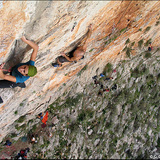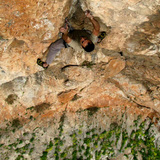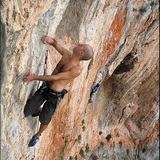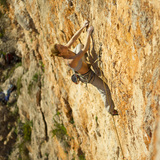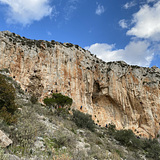Poikilo Oros (465m) is a small -rather insignificant- hill in the west side of Athens. The mountain is known for its severely degraded ecosystem, the result of chaotic building plots, forest fires, mining and the establishment of a major landfill and heavy industries on its foothills.
However, and despite these ominous facts, Poikilo is host to Iera Odos (aka Latsoudorema), a truly special crag hidden and isolated from the surrounding misery in one of the last wild pockets of the otherwise ravaged mountain. The place never fails to amaze first-time visitors, resembling something of a “lost world” of red / grey limestone faces, mountain flora and occasionally passing birdlife.
In terms of quantity, quality, height and bolting, Iera Odos is one of the best choices for sport climbing on easy and moderate grades in Athens. At the same time, it is probably the warmest crag in the city. On a sunny winter day it is not uncommon to climb in a summer outfit.
Naturally, such goodness was appealing to most, and thus Iera Odos reached a golden era of popularity soon after its re-birth as a sport climbing crag. This era came to a sudden end after a series of car break-ins in 2012 and 2013.
Considering its environs and its isolation, it’s hardly surprising that only a few bothered to look at the direction of Poikilo Oros for climbing crags. The place remained quiet till the early nineties. The first recorded climb here is “Kopsin” climbed by Nikos Latsoudis in 1990 with natural protection (now fully bolted). The same, along with members of a small climbing circle aptly named by the climbing scene of the era as “Latsoudoparea” (P. Terlegkas, N. Sakelariou, A. Patzetegos, K. Skoinas et. al.) remained active in the area, during the 90s and climbed many more lines all in trad style.
In 2004 the secret was finally out. H. Orfanoudakis, followed by D. Titopoulos, visited the place and bolted the first sport lines. The new ethics and meticulous cleaning allowed the establishment of the first lines on the red wall which now constitutes the main attraction of the crag. In the following years, the place earned publicity, gradually
becoming one of the most popular climbing spots in Athens. Interestingly enough, Iera Odos is probably the most variably named crag in Athens as well. A dispute of names has become part of its short history.
After interchangeably using at least a dozen names over the years, the climbing community seems to have nowadays settled for “Iera Odos” (chosen by the route establishers to commemorate the ancient “Sacred Way”, a road of ancient religious significance that used to pass nearby). However, more than a few climbers still prefer to use the more mischievous “Latsoudorema” (Greek for “Latsoudis gully”- named after N. Latsoudis who discovered the place -climbingwise- in the 90s). As reported by D. Titopoulos the crag was named Iera Odos with the concent of N. Latsoudis and N. Sakelariou.
